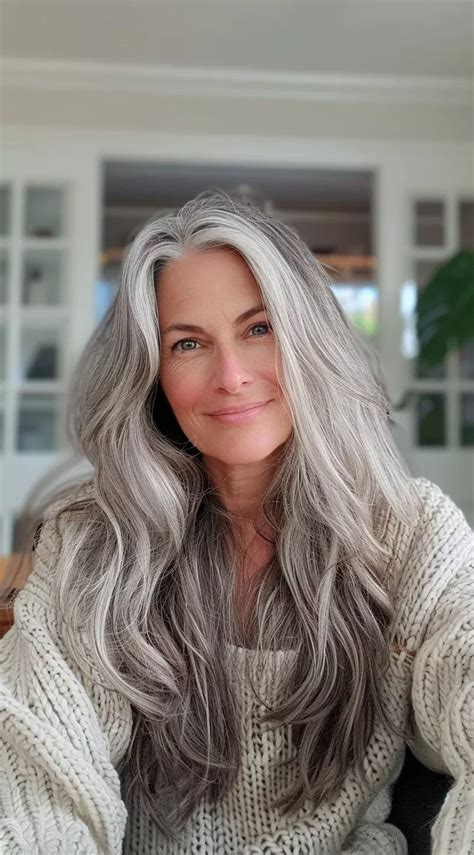Introduction
Gray hair, once considered a sign of aging, is now being embraced as a symbol of beauty and empowerment. With increasing numbers of women choosing to ditch the dye and rock their natural gray locks, there’s a growing need for information and guidance on how to care for and style this unique hair type.

1 in 4 women reports having at least 50% gray hair by age 50.
Understanding Gray Hair
Melanin, the pigment that gives hair its color, gradually decreases with age, resulting in the appearance of gray hair. This process is influenced by several factors, including:
- Genetics: The rate at which gray hair appears is largely determined by genetics.
- Hormonal changes: Fluctuations in hormone levels, especially around menopause, can trigger gray hair growth.
- Stress: Chronic stress can contribute to premature graying.
Embracing Your Gray
Far from being a sign of fading youth, gray hair can add depth, sophistication, and a touch of glamour to any woman. Here are some tips for embracing your gray strands:
Embrace the transition: The transition to gray can be gradual or abrupt. Embrace each stage, experimenting with different hairstyles and colors to find what suits you best.
Find a supportive stylist: A professional stylist can guide you through the transition and help you find flattering styles that enhance your gray hair.
Experiment with color: While embracing your natural gray is a great option, you can also experiment with semi-permanent or permanent dyes to enhance your gray hair’s tone.
Caring for Gray Hair
Gray hair requires specific care to maintain its health and vibrancy. Here’s how:
Use gentle shampoos: Avoid harsh shampoos that contain sulfates or parabens. Opt for sulfate-free shampoos designed for gray hair.
Condition regularly: Gray hair tends to be drier than pigmented hair. Use a moisturizing conditioner regularly to keep it hydrated.
Protect from UV rays: Sunlight can damage gray hair, causing it to become brassy or yellow. Use UV protectant sprays or wear hats when exposed to the sun.
Styling Gray Hair
Gray hair offers a wide range of styling options. Here are some ideas:
Pixie cuts: A pixie cut can add edginess and volume to gray hair, creating a modern and chic look.
Bobs: Bobs are a classic choice for gray hair, offering a sleek and sophisticated style.
Layers: Layers can add movement and dimension to gray hair, creating a flattering and youthful look.
Tips and Tricks
- Embrace the grow-out: Don’t panic if your gray roots start to show. Embrace the transition and enjoy the different shades of gray as they emerge.
- Use a root touch-up spray: Root touch-up sprays can temporarily conceal gray roots until you can get to the salon.
- Try a gray hair blending kit: Gray hair blending kits can help blend your natural gray with dyed hair, creating a more seamless look.
- Experiment with highlights: Highlights can add depth and dimension to gray hair, giving it a more polished appearance.
FAQs
-
Can I prevent gray hair?
While you can’t completely prevent gray hair, you can slow down the process by reducing stress, eating a healthy diet, and protecting your hair from UV rays. -
Is gray hair thinner than other hair?
Yes, gray hair tends to be thinner and more brittle than pigmented hair. This is because the loss of melanin also affects the hair’s structural integrity. -
Can I dye my gray hair back to its original color?
Yes, you can use permanent or semi-permanent dyes to restore your hair’s original color. However, it’s important to note that dyeing gray hair can be more challenging and may require multiple treatments. -
Is gray hair a sign of poor health?
No, gray hair is not typically a sign of poor health. It’s a natural process that is influenced by genetics, hormonal changes, and other factors. -
Is there a difference between gray hair and white hair?
While gray hair and white hair often appear similar, there are subtle differences. Gray hair typically contains some remaining melanin, giving it a silvery or salt-and-pepper appearance. White hair, on the other hand, has no melanin, making it appear more stark and colorless. -
Can stress cause gray hair?
While stress is not a direct cause of gray hair, it can contribute to premature graying by increasing levels of cortisol, a stress hormone that has been linked to hair follicle damage.
Conclusion
Women’s gray hair is a beautiful and versatile hair type that deserves to be celebrated. By understanding the causes and care requirements of gray hair, as well as experimenting with different styles and shades, you can embrace your gray strands with confidence and style.
Additional Resources
- The Gray Hair Revolution: Embracing Your Natural Silver
- Gray Hair: The Ultimate Guide to Caring for and Styling It
- 6 Women on Embracing Their Gray Hair
